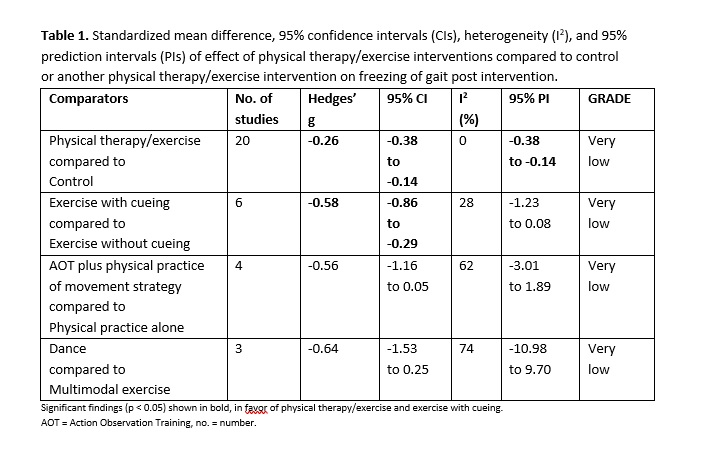Objective: To summarize the effects of rehabilitation interventions to reduce freezing of gait (FOG) in people with Parkinson’s disease (PwPD).
Background: FOG is a debilitating impairment that commonly affects PwPD and may persist despite optimal medical intervention. Rehabilitation interventions may be used as an adjunct to reduce FOG but recent reviews examining the efficacy of rehabilitation were restricted to physical therapy interventions only and did not report prediction intervals (PIs), so the true effect in 95% of comparable studies is unknown.
Method: We conducted a search of randomized trials of rehabilitation interventions (e.g., physical, cognitive, behavioral, occupational and psychotherapies) that reported a FOG outcome up to 1 June 2021. Meta-analyses were performed for studies comparing an intervention to control and comparing two interventions. Quality of included studies and certainty of the pooled FOG outcome were assessed using the PEDro scale and GRADE framework.
Results: Sixty-five studies were eligible, with 62 trialing physical therapy/exercise, and five trialing cognitive and/or behavioral therapies. The overall mean PEDro score of the included studies was 6.1 out of 10. Thirty-two studies contributed to the meta-analyses; 20 compared physical therapy/exercise to control and 13 compared exercise interventions. Pooled FOG outcomes were measured using the FOG/New FOG Questionnaires (FOGQ/NFOGQ). All meta-analyses produced very low-certainty evidence. Physical therapy/exercise had a small effect on reducing FOG compared to control (Table 1). This effect represents a change of 1.1 points on the NFOGQ, whereas 9.95 points is considered the minimal detectable change1. The effect of exercise with cueing; action observation training plus physical movement strategy practice; and dance, when compared to exercise without cueing; physical practice alone; and multimodal exercise respectively, did not favor either intervention in 95% of comparable studies according to the PIs (Table 1).
Conclusion: We are uncertain if physical therapy/exercise, cognitive or behavioral therapies, are effective at reducing FOG. While there was a small, pooled effect in favor of physical therapy/exercise compared to control, its effect is unlikely to be clinically meaningful.
References: 1. Hulzinga F, Nieuwboer A, Dijkstra BW, et al. The New Freezing of Gait Questionnaire: Unsuitable as an Outcome in Clinical Trials? Mov Disord Clin Pract. 2020;7(2):199-205.
To cite this abstract in AMA style:
L. Goh, C. Canning, J. Song, L. Clemson, N. Allen. Effect of rehabilitation interventions on freezing of gait in people with Parkinson’s disease: a systematic review and meta-analyses [abstract]. Mov Disord. 2022; 37 (suppl 2). https://www.mdsabstracts.org/abstract/effect-of-rehabilitation-interventions-on-freezing-of-gait-in-people-with-parkinsons-disease-a-systematic-review-and-meta-analyses/. Accessed April 2, 2025.« Back to 2022 International Congress
MDS Abstracts - https://www.mdsabstracts.org/abstract/effect-of-rehabilitation-interventions-on-freezing-of-gait-in-people-with-parkinsons-disease-a-systematic-review-and-meta-analyses/

